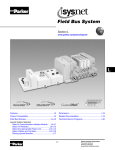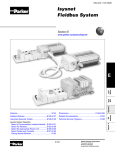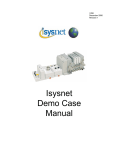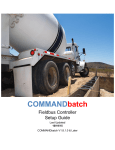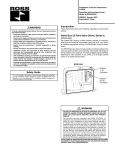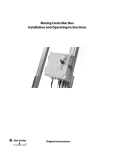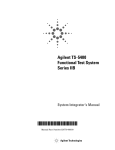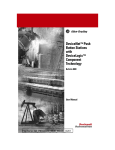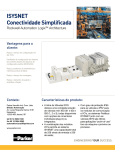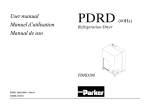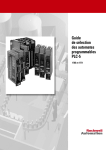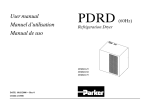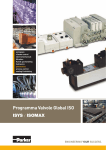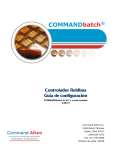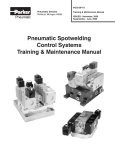Download isysnet, Expansion Power Unit
Transcript
Pneumatic Division Richland, Michigan USA www.parker.com/pneumatics Maintenance / Installation / Service Instruction Sheets Click on bulletin below to view instruction sheet in PDF format. Expansion Power Unit, PSSSE24A (24VDC) Document Number Description E105P Isysnet 24VDC Expansion Power Supply, Series A PSS-SG001 Isysnet Serial Bus System Selection Guide Installation & Service Instructions E105P Pneumatic Division Richland, Michigan 49083 Isysnet 24VDC Expansion Power Supply, Series A (PSSSE24A) ISSUED: January, 2007 Supersedes: June, 2005 Doc.# E105P, ECN# 060961, Rev. 2 ! WARNING • To avoid unpredictable system behavior that can cause personal injury and property damage: • Disconnect electrical supply (when necessary) before installation, servicing, or conversion. • Disconnect air supply and depressurize all air lines connected to this product before installation, servicing, or conversion. • Operate within the manufacturer’s specified pressure, temperature, and other conditions listed in these instructions. • Medium must be moisture-free if ambient temperature is below freezing. • Service according to procedures listed in these instructions. • Installation, service, and conversion of these products must be performed by knowledgeable personnel who understand how pneumatic products are to be applied. • After installation, servicing, or conversion, air and electrical supplies (when necessary) should be connected and the product tested for proper function and leakage. If audible leakage is present, or the product does not operate properly, do not put into use. • Warnings and specifications on the product should not be covered by paint, etc. If masking is not possible, contact your local representative for replacement labels. PSSSE24A 24VDC Expansion Power Supply PSSSE24A 24V dc Power Supply Wire Marker System Power Field Power Mini 7/8” Power Connector LED Indicators P AO UW XE R ATTENTION Safety Guide For more complete information on recommended application guidelines, see the Safety Guide section of Pneumatic Division catalogs or you can download the Pneumatic Division Safety Guide at: www.parker.com/safety Introduction Follow these instructions when installing, operating, or servicing the product. Isysnet 24VDC Expansion Power Supply, Series A ! Do not connect 120/240VAC to the PSSSE24A terminals. Damage to the supply will result. ATTENTION ! You can only use the PSSSE24A expansion power unit with the I/O adapters. (PSSSE24A) The 24VDC expansion power supply unit (PSSSE24A) passes 24VDC field power to the I/O modules to the right of the power supply. This unit extends the backplane bus power for up to 17 I/O modules to the right of the supply and creates a new field voltage partition. The expansion power supply also separates field power from I/O modules to the left of the unit, effectively providing functional and logical partitioning for: • separating field power between input and output modules • separating field power to the analog and digital modules • grouping modules to perform a specific task or function You can use multiple expansion power units with the I/O adapters to assemble a full system. For instance, if you are using the PSSCDM12A or PSSCDM18PA adapter, you may use a PSSSE24A expansion power unit to add additional modules in 5 to 17 module increments. For example, if you had a 36 module system with a I/O adapter, you would have two PSSSE24A expansion power units to provide more PointBus current for modules to the right of the supply. ! WARNING FAILURE OR IMPROPER SELECTION OR IMPROPER USE OF THE PRODUCTS AND/OR SYSTEMS DESCRIBED HEREIN OR RELATED ITEMS CAN CAUSE DEATH, PERSONAL INJURY AND PROPERTY DAMAGE. This document and other information from Parker Hannifin Corporation, its subsidiaries and authorized distributors provide product and/or system options for further investigation by users having technical expertise. It is important that you analyze all aspects of your application, including consequences of any failure and review the information concerning the product or systems in the current product catalog. Due to the variety of operating conditions and applications for these products or systems, the user, through its own analysis and testing, is solely responsible for making the final selection of the products and systems and assuring that all performance, safety and warning requirements of the application are met. The products described herein, including without limitation, product features, specifications, designs, availability and pricing, are subject to change by Parker Hannifin Corporation and its subsidiaries at any time without notice. EXTRA COPIES OF THESE INSTRUCTIONS ARE AVAILABLE FOR INCLUSION IN EQUIPMENT / MAINTENANCE MANUALS THAT UTILIZE THESE PRODUCTS. CONTACT YOUR LOCAL REPRESENTATIVE. Isysnet 24VDC Expansion Power Supply, Series A (PSSSE24A) Important User Information ATTENTION Solid state equipment has operational characteristics differing from those of electromechanical equipment. Safety Guidelines for the Application, Installation and Maintenance of Solid State Controls (available online at www.parker.com/pneu/isysnet) describes some important differences between solid state equipment and hard-wired electromechanical devices. Because of this difference, and also because of the wide variety of uses for solid state equipment, all persons responsible for applying this equipment must satisfy themselves that each intended application of this equipment is acceptable. ! Environment and Enclosure This equipment is intended for use in overvoltage Category II applications (as defined in IEC publication 60664-1), at altitudes up to 2000 meters without derating. This equipment is considered Group 1, Class A industrial equipment according to IEC/CISPR Publication 11. Without appropriate precautions, there may be potential difficulties ensuring electromagnetic compatibility in other environments due to conducted as well as radiated disturbance. This equipment is supplied as “enclosed” equipment. It should not require additional system enclosure when used in locations consistent with the enclosure type ratings stated in the Specifications section of this publication. Subsequent sections of this publication may contain additional information regarding specific enclosure type ratings, beyond what this product provides, that are required to comply with certain product safety certifications. NOTE: See NEMA Standards publication 250 and IEC publication 60529, as applicable, for explanations of the degrees of protection provided by different types of enclosure. Also, see the appropriate sections in this publication, as well as the publication E115P (“Industrial Automation Wiring and Grounding Guidelines”), for additional installation requirements pertaining to this equipment. In no event will Parker Hannifin Corporation be responsible or liable for indirect or consequential damages resulting from the use or application of this equipment. The examples and diagrams in this manual are included solely for illustrative purposes. Because of the many variables and requirements associated with any particular installation, Parker Hannifin Corporation cannot assume responsibility or liability for actual use based on the examples and diagrams. No patent liability is assumed by Parker Hannifin Corporation with respect to use of information, circuits, equipment, or software described in this manual. Reproduction of the contents of this manual, in whole or in part, without written permission of Parker Hannifin Corporation is prohibited. Throughout this manual we use notes to make you aware of safety considerations. WARNING ! Identifies information about practices or circumstances that can cause an explosion in a hazardous environment, which may lead to personal injury or death, property damage, or economic loss. IMPORTANT Identifies information that is critical for successful application and understanding of the product. ATTENTION Identifies information about practices or circumstances that can lead to personal injury or death, property damage, or economic loss. Attentions help you: ! ATTENTION ! Preventing Electrostatic Discharge This equipment is sensitive to electrostatic discharge, which can cause internal damage and affect normal operation. Follow these guidelines when you handle this equipment: •Touch a grounded object to discharge potential static. •Wear an approved grounding wriststrap. •Do not touch connectors or pins on component boards. •Do not touch circuit components inside the equipment. •If available, use a static-safe workstation. •When not in use, store the equipment in appropriate staticsafe packaging. • Identify a Hazard • Avoid a Hazard • Recognize the Consequence SHOCK HAZARD Labels may be located on or inside the equipment to alert people that dangerous voltage may be present. BURN HAZARD Labels may be located on or inside the equipment to alert people that surfaces may be dangerous temperatures. E105P 2 Isysnet 24VDC Expansion Power Supply, Series A (PSSSE24A) E105P Mount the I/O Base To mount the I/O base on a wall or panel, use the screw holes provided in the base. IMPORTANT The I/O module must be mounted on a grounded metal mounting plate or other conductive surface. A mounting illustration for the base with an adapter is shown below. 1.9 (47.2) 2.0 (50) 0.87 (22) 2.0 (50) 3.13 (79.4) 5.98* (151.9) Adapter 2.39 (60.7) 4.02 (102) 4.32 (109.8) 1.81 (46) Inches (mm) Drill and Tap for M4 Screw 3.02 (76.6) 5.39 (137.0) Drill and Tap for M6 Screw *Depending on the type and number of manifolds, this dimension may vary. Refer to Catalog 0600P-# for additional information. Install the Mounting Base as Follows: 1.Lay out the required points as shown above in the drilling dimension drawing. 2.Drill the necessary holes for #8 (M4) machine or self-tapping screws. 3.Mount the base using #8 (M4) screws. 4.Ground the system using the ground lug connection. (The ground lug connection is also a mounting hole.) Mounting Base KeyswitchSet to position 1 for the PSSSE24A dc expansion power supply Ground Lug Connection Latching Mechanism 3 Isysnet 24VDC Expansion Power Supply, Series A (PSSSE24A) E105P Install the 24VDC Expansion Power Supply Wire the 24VDC Expansion Power Supply To Install the Power Supply, Proceed as Follows: 1.Using a bladed screwdriver, rotate the keyswitch on the mounting base clockwise until the number 1 aligns with the notch in the base. 2.Position the power supply vertically above the mounting base. The module will bridge two bases. Following are wiring instructions for the 24VDC Expansion Power Supply. PSSSE24A Module Will Bridge Two Bases Male In Connector (Mini 7/8”) (view into connector) Pin 1-User Power + Pin 2-Adapter Power + PSSSE24A 24V dc Power Supply Pin 3-Adapter Power Pin 4-User Power - Note:User power is the 24VDC power for field devices. Adapter power is the 24VDC power for PSSSE24A. It is converted to 5VDC to power isysNet modules. System Power Field Power P AO W U XE R ATTENTION ! 3.Push the power supply down until it engages the orange latching mechanism. You will hear a clicking sound when the power supply is properly engaged. The locking mechanism will lock the power supply to the base. Make sure all connectors and caps are securely tightened to properly seal the connections against leaks and maintain IP67 requirements. Remove the 24VDC Expansion Power Supply From the Mounting Base To Remove the Power Supply from the Mounting Base: 1.Put a flat blade screwdriver into the slot of the orange latching mechanism. 2.Push the screwdriver toward the I/O module to disengage the latch. The module will lift up off the base. 3.Pull the module off of the base. Install a Replacement PSSSE24A to an Existing System 1.Remove the module to the right of the power supply from the mounting base. 2.If you have not done so already, remove the existing power supply from the mounting base. 3.Position the replacement power supply vertically above the mounting base. 4.Push the power supply down until it engages the orange latching mechanism. You will hear a clicking sound when the power supply is properly engaged and locked to the base. 5.Place the module to the right of the power supply back onto the mounting base. 4 Isysnet 24VDC Expansion Power Supply, Series A (PSSSE24A) E105P Specifications Following are specifications for the PSSSE24A Power Supply. 24VDC Expansion Power Supply - PSSSE24A I/O Module Capacity 5 to 17 I/O modules depending on each module's current rating Power Supply adapter. In order to comply with CE Low Voltage Directives (LVD), you must use a Safety Extra Low Voltage (SELV) or a Protected Extra Low Voltage (PELV) power supply to power the Inputs Voltage Rating 12VDC, 24VDC nominal 10-28.8VDC range Operating Voltage 10-28.8VDC Input Current, Maximum 6A for 10ms Backplane Output Current 5VDC, 1.3A Field Side Power Requirements, Maximum 24VDC (+20% = 28.8VDC) @ 400 mA Indicators 1 Green Field Power Status Indicator 1 Green 5V System Power Indicator Module Location Between I/O modules in system Breaks field power bus PointBus Output Current 1A at 10-19.2V input; 1.3A at 19.2-28.8V input Input Overvoltage Protection Reverse polarity protected Interruption Output voltage will stay within specifications when input drops out for 10ms at 10V with maximum load General Specifications Power Consumption, Maximum 9.8W @ 28.8VDC Power Dissipation, Maximum 3.0W @ 28.8VDC Thermal Dissipation, Maximum 10.0 BTU/hr. @ 28.8VDC Isolation Voltage (continuous-voltage withstand rating) 50V rms Tested at 1250VAC rms for 60s Field Power Bus Supply Voltage Voltage Range Supply Current 12VDC, 24VDC nominal 10-28.8VDC range 10A maximum Dimensions Inches (Millimeters) 1.25H x 2.63W x 4.25D (31.75H x 66.80W x 107.95D) Operating Temperature IEC 60068-2-1 (Test Ad, Operating Cold), IEC 60068-2-2 (Test Bd, Operating Dry Heat), IEC 60068-2-14 (Test Nb, Operating Thermal Shock): -20 to 60°C (-4 to 140°F) Storage Temperature IEC 60068-2-1 (Test Ab, Un-packaged Non-operating Cold), IEC 60068-2-2 (Test Bb, Un-packaged Non-operating Dry Heat), -40 to 85°C (-40 to 185°F) Relative Humidity IEC 60068-2-30 (Test Db, Un-packaged Non-operating Damp Heat): 5-95% non-condensing Shock IEC60068-2-27 (Test Ea, Unpackaged Shock): Operating 30g Non-operating 50g Vibration IEC60068-2-6 (Test Fc, Operating): 5g @ 10-500Hz ESD Immunity IEC 61000-4-2: 6kV contact discharges 8kV air discharges Radiated RF Immunity IEC 61000-4-3: 10V/m with 1kHz sine-wave 80%AM from 30MHz to 2000MHz 10V/m with 200Hz 50% Pulse 100%AM at 900Mhz 10V/m with 200Hz 50% Pulse 100%AM at 1890Mhz 5 Isysnet 24VDC Expansion Power Supply, Series A (PSSSE24A) E105P General Specifications (continued) EFT/B Immunity IEC 61000-4-4: ±4kV at 5kHz on power ports Surge Transient Immunity IEC 61000-4-5: ±1kV line-line(DM) and ±2kV line-earth(CM) on power ports Conducted RF Immunity IEC 61000-4-6: 10Vrms with 1kHz sine-wave 80%AM from 150kHz to 80MHz Emissions CSPR 11: Group 1, Class A Enclosure Type Rating Meets IP65/66/67 (when marked) Mounting Base Screw Torque #8 screw, 7.5 in. lbs. in Aluminum, 16 in. lbs. in Steel Weight Imperial (Metric) 0.637 lb. (0.289 kg) Wiring Category 1 - on power ports Keyswitch Position 1 Certifications: (when product is marked) c-UL-us 1 UL Listed Industrial Control Equipment, certified for US and Canada CE European Union 89/336/EEC EMC Directive, compliant with: EN 61000-6-4; Industrial Emissions EN 50082-2; Industrial Immunity EN 61326; Meas./Control/Lab., Industrial Requirements EN 61000-6-2; Industrial Immunity C-Tick Australian Radiocommunications Act, compliant with: AS/NZS CISPR 11; Industrial Emissions 1.Use this Conductor Category information for planning conductor routing. Refer to Publication E115P, “Industrial Automation Wiring and Grounding Guidelines”. 6 Pneumatic Isysnet Serial Bus System Selection Guide Isysnet The Isysnet System Isysnet Features Isysnet has four major components: • Highly modular design (1pt — 8pt modularity) • Valve driver module provide control for 32 solenoids • Broad application coverage • I/O modules provide the field interface, system-interface circuitry, and bases for mounting • Channel-level diagnostics (LED and electronic) • Communication interface modules provide the networkinterface circuitry • Channel-level open-wire detection with electronic feedback • Power distribution module provide the solution to expandability of the Isysnet system • Channel-level alarm and annunciation (electronic) • Channel-level short-circuit detection with electronic feedback • Parameter-level explicit messaging • Removal and insertion under power (RIUP) • DeviceNet™ expansion • Horizontal and vertical mounting without derating • 5g vibration • Flash upgradable adapters and digital I/O • Electronic and mechanical keying • Robust backplane design • Hot swapping of I/O modules • Quick-disconnects for I/O and network connectivity • Built-in panel grounding • Color-coded module labels • UL, C-UL, and CE certifications (as marked) • Highly reliable structural integrity • Optical isolation between field and system circuits Publication PSS-SG001A-EN-P – June 2005 Isysnet 1 Isysnet Product Compatibiliy The following chart illustrates the compatibility of Isysnet with other control platforms, especially with Rockwell Automation. For information regarding the differences between the networks and Isysnet, please refer to the Selecting a Network Interface section in this document. DeviceNet Adapter PSSCDM ControlNet Adapter PSSCCNA EtherNet Adapter PSSCENA PROFIBUS Adapter PSSCPBA PLC-5™ with Network Port IOD NS NS NA SLC 500™ with Network Port IOD NS NS NA PLC-5 Processor via Network Module IOD NS NS 3 1756 Logix™ Communication Interface IOD IOD IOD 3 PanelView™ Terminal NA NA NA NA RSLinx™ Software NA NA NA NA 1769-L20, -L30 Controller with 1761- NET Interface NA NS NS NA 1769-L35E NA NA IOD NA SoftLogix5800™ NS NS NS NA PC with RSLinx Only NS NS NS NA IOD = I/O Data NS = Not Supported NA = Not Applicable 3 = Requires third party scanner module Communication Considerations Isysnet features are impacted by your network choice. Network Impact DeviceNet PSSCDM12A and PSSCDM18PA The PSSCDM12A and PSSCDM18PA provide two means of connecting a node of I/O to DeviceNet. A total of 63 Isysnet modules can be assembled on a single DeviceNet node. Expansion power supplies may be used to provide additional PointBus backplane current. ControlNet™ PSSCCNA A total of 63 Isysnet modules can be assembled on a single ControlNet node. Expansion power supplies may be used to provide additional PointBus backplane current. Up to 25 direct connections and 5 rack connections are allowed. EtherNet/IP™ PSSCENA A total of 63 Isysnet modules can be assembled on a single EtherNet/IP node. Expansion power supplies may be used to provide additional PointBus backplane current. Refer to the User Manual, publication PSS-UM004 to determine the ratings for direct and rack connections allowed. PROFIBUS DP™ PSSCPBA A total of 63 Isysnet modules can be assembled on a single PROFIBUS node. Expansion power supplies may be used to provide additional PointBus backplane current. Publication PSS-SG001A-EN-P – June 2005 2 Isysnet Specifying an Isysnet System Follow these steps as you specify your Isysnet system: Step 1 Select a Communication Interface Module See Page NetLinx™ Architecture 2 Selecting a Network 3 Selecting the DeviceNet Communication Interface 3 Location of the device Digital I/O Modules 6 Number of Isysnet modules needed Analog I/O Modules 7 Appropriate catalog number Specialty I/O Module 9 Number of I/O available per module Valve Driver Module 10 Expansion Power Unit 10 Typical Configurations 12 4 Select Accessories Cables and Cordsets 13 5 Placing Isysnet Modules Placing Isysnet Modules 15 Mounting the Isysnet System 16 Choose the interface module for your operating system. 2 Select I/O Devices Based on Field Devices Number of modules 3 Select Optional Power Component Choose optional component to extend backplane power Determine necessary dimensions based on the communication interface chosen. Step 1 - Select a Communication Interface Module Selecting Isysnet Communication Interfaces Rockwell Automation NetLinx Architecture Separate communication interface adapters are available for different networks. Install adapters into the PointBus backplane to allow Isysnet modules to communicate with a controller. • EtherNet/IP is an open industrial networking standard that supports implicit and explicit messaging and uses commercial, off-the-shelf EtherNet equipment and physical media. NetLinx open network architecture is the Rockwell Automation strategy of using open networking technology for seamless, top-floor to shop-floor integration. The networks in the NetLinx architecture, DeviceNet, ControlNet, and EtherNet/IP, speak a common language and share a universal set of communication services. NetLinx architecture, part of the Integrated Architecture, seamlessly integrates all the components in an automation system from a few devices on one network to multiple devices on multiple networks including access to the Internet, helping you to improve flexibility, reduce installation costs, and increase productivity. • ControlNet allows intelligent, high-speed control devices to share the information required for supervisory control, workcell coordination, operator interface, remote device configuration, programming, and troubleshooting. Publication PSS-SG001A-EN-P – June 2005 • DeviceNet offers high-speed access to plant-floor data from a broad range of plant-floor devices and a significant reduction in wiring. Isysnet 3 Selecting a Network You can configure your system for information exchange between a range of devices and computing platforms and operating systems. Application Requirements Network Select EtherNet/IP PSSCENA ControlNet PSSCCNA • Plant management (material handling) • Configuration, data collection, and control on a single, high-speed network • Time-critical applications with no established schedule • Data sent regularly • Internet/Intranet connection • High-speed transfer of time-critical data between controllers and I/O devices • Deterministic and repeatable data delivery • Media redundancy • Controller redundancy • Intrinsic safety • Redundant controller systems • Connections of low-level devices directly to plant-floor controllers, without interfacing them • Data sent as needed PSSCDM12A • More diagnostics for improved data collection and fault detection DeviceNet PSSCDM18PA PROFIBUS PSSCPBA • Less wiring and reduced start-up time than a traditional, hard-wired system • Connecting to an existing PROFIBUS DP 5m bus, 12 MB network Selecting the DeviceNet Communication Interface Isysnet offers two interfaces for connecting to DeviceNet. Refer to the following table. For These Features Remember Select • Behaves as a slave device on the Main Network and a master on the PointBus • All Isysnet modules count as a single node on the Main Network PSSCDM12A (M12-style network connectors) • Allows a group of I/O modules on the Subnet to act as a single node on the Main Network • The Main Network distance is acceptable PSSCDM18PA (mini-style network connectors with pass-through) • RSNetWorx™ for DeviceNet software is needed for configuration of the PSSCDM12A or PSSCDM18PA on the Main Network and the PointBus • Isysnet expansion power supplies are permitted to add more Isysnet modules. • Configuration on the PointBus consists of a scan list that is very similar to those used in all of the DeviceNet master scanner modules Publication PSS-SG001A-EN-P – June 2005 4 Isysnet With the introduction of the PSSS23A module, the amount of data to be transferred over the Subnet could become substantial. It is important that the total amount of data coming from the Subnet does not exceed the data capability of either the PSSCDM12A or PSSCDM18PA. • 250 bytes (248 data + 2 bytes command info) for output data (used as either COS, cyclic, or poll) • 250 bytes (248 data + 2 bytes status info) for polled input data • 250 bytes (248 data + 2 bytes status info) for COS/cyclic input data • 8 bytes (6 data + 2 status info) for strobe input data Publication PSS-SG001A-EN-P – June 2005 The data coming through the PSS adapter combined with the other data from the Main Network cannot exceed the data capability of the Main Network master scanner. If this occurs, you will need multiple master scanners on the Main Network and the I/O modules on the Subnet will need to be split between multiple PSSCDM12A or PSSCDM18PA adapters. Isysnet 5 Step 2 - Select I/O Modules Selecting Isysnet Modules Some modules have diagnostic features, electronic fusing, or individually isolated inputs/outputs. The Isysnet family provides a wide range of input and output modules to span many applications, from high-speed discrete to process control. Isysnet supports producer/consumer technology, which allows input information and output status to be shared among multiple Logix controllers. PSST8M8A 24V dc Out PSSCDM12A PSSN8M12A 24V dc In 0 2 1 3 PSST8M12A 24V dc Out 0 2 1 3 PSSV32A DeviceNet Out Adapter Status DeviceNet In 0 0 2 6 x10 4 2 8 6 4 MOD 3 0 1 1 1 3 5 2 4 6 4 5 6 Net 0 2 4 Mod NET 0 Adapter Power x1 MOD NET System Power PWR MOD NET 2 0 8 1 DeviceNet Status PointBus Status 3 2 4 6 5 7 4 5 7 5 Fault 3 4 5 6 6 6 7 7 7 7 The Isysnet family of I/O modules includes: • Digital I/O Modules • Analog I/O Modules • Specialty I/O Module • Valve Driver Module Publication PSS-SG001A-EN-P – June 2005 6 Isysnet Digital I/O Modules Digital DC Input Modules Choose digital I/O modules when you need: PSSN8M8A PSSN8M12A PSSN8M23A PSSP8M8A PSSP8M12A PSSP8M23A Number of Inputs 8 Sinking 8 Sourcing Keyswitch Position 1 1 Voltage, On-State Input, Nom. 24VDC 24VDC - Logic circuits process the signal. Voltage, On-State Input, Min. 10VDC 10VDC - An input LED turns on or off indicating the status of the corresponding input device. Voltage, On-State Input, Max. 28.8VDC 28.8VDC 0.5 ms hardware + (0…65 ms selectable)* 0.5 ms hardware + (0…65 ms selectable)* Current, On-State Input, Min. 2 mA 2 mA Current, On-State Input, Max. 5 mA 5 mA Current, Off-State Input, Max. 1.5 mA 1.5 mA PointBus Current (mA) 75 75 1.0 W @ 28.8VDC 1.0 W @ 28.8VDC • Input Modules. An input module responds to an input signal in the following manner: - Input filtering limits the effect of voltage transients caused by contact bounce and/or electrical noise. If not filtered, voltage transients could produce false data. All input modules use input filtering. - Optical isolation shields logic circuits from possible damage due to electrical transients. • Output Modules. An output module controls the output signal in the following manner: Input Delay Time, ON to OFF - Logic circuits determine the output status. - An output LED indicates the status of the output signal. - Optical isolation separates module logic and bus circuits from field power. - The output driver turns the corresponding output on or off. • Surge Suppression. Most output modules have built-in surge suppression to reduce the effects of high-voltage transients. However, we recommend that you use an additional suppression device if an output is being used to control inductive devices, such as: - Relays - Motor starters - Solenoids Power Dissipation, Max. * Input ON-to-OFF delay time is the time from a valid input signal to recognition by the module. - Motors Additional suppression is especially important if your inductive device is in series with, or parallel to, hard contacts such as: Digital DC Output Modules PSST8M8A PSST8M12A PSST8M23A - Push buttons - Selector switches The digital I/O modules support: • A wide variety of voltage interface capabilities Number of Outputs 8 sourcing Keyswitch Position 1 Voltage, On-State Output, Nom. 24VDC Voltage, On-State Output, Min. 10VDC Voltage, On-State Output, Max. 28.8VDC • Isolated and non-isolated module types • Point-level output fault states • Choice of direct-connect or rack-optimized communications • Field-side diagnostics on select modules Connector types are indicated by the catalog number. For example, the PSSN8M12A has an M12 connector. Publication PSS-SG001A-EN-P – June 2005 Output Current Rating, Max. 3.0 A per module, 1.0 A per channel PointBus Current (mA) 75 Power Dissipation, Max. 1.2 W @ 28.8VDC Isysnet 7 Relay Output Module PSSTR4M12A Number of Outputs 4 Form A (N.O.) relays, isolated Keyswitch Position 7 Output Delay Time, ON to OFF, Max. 26 ms* Contact Resistance, Initial 30 mΩ Current Leakage, Off-State Output, Max. 1.2 mA and bleed resistor thru snubber circuit @ 240V ac PointBus Current (mA) 90 Power Dissipation, Max. 0.5 W *Time from valid output off signal to relay deenergization by module. Analog I/O Modules The Isysnet analog modules support: on-board, channel-level data alarming (four set-points per channel); scaling to engineering units; channel-level diagnostics (electronic bits and LEDs); and integer format. • Over- and under-range detections and indications. This eliminates the need to test values in the control program, saving valuable processing power of the controller. In addition, since alarms are handled by the module, the response is faster and only a single bit per channel is monitored to determine if an error condition has occurred. • Ability to direct output device operation during an abnormal condition. Each channel of the output module can be individually configured to hold its last value or assume a user-defined value on a fault condition. This feature allows you to set the condition of your analog devices, and therefore your control process, which may help to ensure a reliable shutdown. • Ability to individually enable and disable channels. Disabling unused channels improves module performance. • Selectable input filters This lets you select the filter frequencies for each channel that best meets the performance needs of your application based on environmental limitations. Lower filter settings provide greater noise rejection and resolution. Higher filter settings provide faster performance. Note: The analog modules provide four input filter selections. • Selectable response to broken input sensor. This feature provides feedback to the controller that a field device is not connected or operating properly. This lets you specify corrective action based on the bit or channel condition. • High accuracy. The modules share a high accuracy rating of ±0.1% of full-scale accuracy at 25 °C. Choose analog I/O modules when you need: • Individually configurable channels to use the module(s) with a variety of sensors. • On-board scaling to eliminate the need to scale the data in the controller. Controller processing time and power are preserved for more important tasks, such as I/O control, communications, or other user-driven functions. • On-line configuration. Modules can be configured in the RUN mode using the programming software or the control program. This allows you to change configuration while the system is operating. For example, the input filter for a particular channel could be changed, or a channel could be disabled based on a batch condition. To use this feature, the controller and network interface must also support this feature. Publication PSS-SG001A-EN-P – June 2005 8 Isysnet Analog Input Modules PSSNACM12A PSSNAVM12A Number of Inputs 2 2 Keyswitch Position 3 3 Input Signal Range 4…20 mA 0…20 mA 0…10V ±10V Input Resolution, Bits 16 bits - over 21 mA 0.32 µA/cnt 15 bits plus sign 320 µV/cnt inunipolar or bipolar mode Absolute Accuracy, Current Input 0.1% Full Scale @ 25°C*† — Absolute Accuracy, Voltage Input — 0.1% Full Scale @ 25°C*† Input Step Response, per Channel 70 ms @ Notch = 60 Hz (default) 80 ms @ Notch = 50 Hz 16 ms @ Notch = 250 Hz 8 ms @ Notch = 500 Hz 70 ms @ Notch = 60 Hz (default) 80 ms @ Notch = 50 Hz 16 ms @ Notch = 250 Hz 8 ms @ Notch = 500 Hz Input Conversion Type Delta Sigma Delta Sigma PointBus Current (mA) 75 75 Power Dissipation, Max. 0.6 W @ 28.8VDC 0.6 W @ 28.8VDC * Includes offet, gain, non-linearity and repeatability error terms. † Analog input modules support these configurable parameters and diagnostics: open-wire with LED and electronic reporting; four-alarm and annunciation set-points; calibration mode and electronic reporting; under- and over-range and electronic reporting; channel signal range and update rate and on-board scaling; filter-type; channel update rate. Analog Output Modules PSSTACM12A PSSTAVM12A Number of Outputs 2 2 Keyswitch Position 4 4 Output Signal Range 4…20 mA 0…20 mA 0…10V ±10V Output Resolution, Bits 13 bits - over 21 mA 2.5 µA/cnt 14 bits (13 plus sign) 1.28 mV/cnt inunipolar or bipolar mode Absolute Accuracy, Current Output 0.1% Full Scale @ 25°C*† — Absolute Accuracy, Voltage Output — 0.1% Full Scale @ 25°C*† Step Response to 63% of FS, Current Output 24 µs — Step Response to 63% of FS, Voltage Output — 20 µs Output Conversion Rate 16 µs 20 µs PointBus Current (mA) 75 75 Power Dissipation, Max. 1.0 W @ 28.8VDC 1.0 W @ 28.8VDC * Includes offet, gain, non-linearity and repeatability error terms. † Analog output modules support these configurable parameters and diagnostics: open-wire with LED and electronic reporting (PSSTACM12A only); fault mode; idle mode; alarms; channel signal range and on-board scaling. Publication PSS-SG001A-EN-P – June 2005 Isysnet 9 Specialty I/O Module PSSS23A The PSSS23A serial-interface module offer a serial-link communication interface solution for peripheral products with RS-232 port. The module allows a device with serial-interface output, i.e., bar code readers, to communicate up to 128 bytes of ASCII data onto any network supported by Isysnet. Each module is a single-channel, full-duplex interface and is rated for up to 38.4 kbaud. LED indicators on the module offer diagnostics for the module, Isysnet PointBus backplane, and transmit/ receive status indication. Isysnet ASCII Module Specifications PSSS23A Number of Serial Channels 1 Keyswitch Position 2 (Specialty) PointBus Current (mA) 75 Power Dissipation 1.75 W @ 28.8VDC Serial Port Parameters Serial Character Framing 7N2, 7E1, 7O1, 8N2, *E1, 8O1, 7E2, 7O2 Serial Port Comm Speed 9600, 1200, 2400, 4800, 19.2 k, 38.4 k Serial Port Receive from ASCII Device Number of Receive Chars, Max 1...128 Receive Record Start Mode No, exclude, include start delimiter Receive Start Delimiter ASCII character Receive Record End Mode No, exclude, include end delimiter Receive End Delimiter ASCII character Send (Produce) on DeviceNet to Master Receive String Data Type Array, short-string, string Pad Mode Pad mode disabled, enabled Pad Character ASCII character Receive Swap Mode Disabled, 16-bit, 24-bit, 32-bit swap DeviceNet Handshake Mode Master/slave handshake, produce immediate Produce Assembly Size 4...132 Serial Data Size 0...128 bytes Receive Transaction ID 0...255 Serial Port Transmit to ASCII Device Number of Transmit Chars, Max 1...128 Transmit End Delimiter Mode No, exclude, include end delimiter Transmit End Delimiter Character ASCII Consume on DeviceNet from Master Consume String Data Type Array, short-string, string Transmit Swap Mode Disabled, 16-bit, 24-bit, 32-bit swap DeviceNet Record Header Mode Transmit handshake/immediate Consume Assembly Size 4...132 Serial Port Transmit/Explicit Messages from Configuration Tool Transmit Serial Data String Size 0...128 bytes Transmitted Serial Data Length 0...128 bytes Transmit Transaction ID 0...255 Serial Port Status TX FIFO overflow, RX FIFO overflow, RX parity error, handshake error, new data flag Publication PSS-SG001A-EN-P – June 2005 10 Isysnet Valve Driver Module PSSV32A The PSSV32A valve driver module provides an interface between the Isysnet serial bus system and the Isys valve assembly. This module will always be the last module on the Isysnet serial bus. It controls 32 digital outputs at 24VDC. Depending on the valve selection, it can control up to 32 single solenoid valves or 16 double solenoid valves. Valve Driver Module Specifications PSSV32A Outputs per Module 32, sourcing Voltage Drop, On-State Output, Maximum 0.2VDC Voltage, Off-State Output, Maximum 28.8VDC Voltage, On-State Output, Maximum Minimum Nominal 28.8VDC 10VDC 24VDC Output Current Rating 200 mA per channel, not to exceed 6.0 A per module Output Surge Current, Maximum 0.5 A for 10 ms, repeatable every 3 seconds Current Leakage, Off-State Output, Maximum 0.1 mA Current, On-State Output Minimum 200 mA per channel Output Delay Time OFF to ON, Maximum 1 Output Delay Time, ON to OFF, Maximum 1 0.1 ms 0.1 ms External DC Power Supply Voltage Range 10 to 28.8VDC External DC Power Supply Voltage Nominal 24VDC 1. OFF to ON or ON to OFF delay is time from a valid output “on” or “off” signal to output energization or de-energization. Step 3 - Select the Appropriate Power Unit Selecting a Power Supply Unit Isysnet adapters have built-in PointBus power supplies. All Isysnet modules are powered from the PointBus by either an adapter or expansion power supply. Power Specifications Cat. No. Power Supply Input Voltage, Nom. Operating Voltage Range Field Side Power Reuirements, Max. Power Supply Inrush Current, Max. Input Overvoltage Protection Power Supply Interruption Protection Reverse polarity protected Output voltage will stay within specifications when input drops out for max. load. PSSCDM12A PSSCDM18PA PSSCCNA PSSCENA 24VDC 10...28.8VDC PSSCPBA 24VDC (+20% = 28.8VDC) @ 400 mA PSSSE24A Power units are divided into two categories: • Communication adapters with built-in power supply (dc-dc) • Expansion power supply Publication PSS-SG001A-EN-P – June 2005 6 A for 10 ms Isysnet Expansion Power Unit 11 PSSSE24A Current Derating for Mounting The PSSSE24A expansion power unit passes 24VDC field power to the I/O modules to the right of it. This unit extends the backplane bus power and creates a new field voltage partition segment for driving field devices for up to 13 I/O modules. The expansion power unit separates field power from I/O modules to the left of the unit, effectively providing functional and logical partitioning for: 1.3 1.0 Current • Separating field power between input and output modules • Separating field power to the analog and digital modules Horizontal - 1 A @ (10-19.2V); 1.3 A @ (19.2-28.8V) Vertical - 1 A @ (10-28.8V) 0.5 • Grouping modules to perform a specific task or function You can use multiple expansion power units with any of the communication adapters to assemble a full system. If you are using the PSSCDM12A adapter, you may use a PSSSE24A expansion power unit to add additional modules. For example, if you had a 36 module system with a PSSCDM12A adapter, you would have at least two or more PSSSE24A expansion power units to provide more PointBus current for modules to the right of the supply. 10 19.2 Voltage 28.8 • 24VDC to 5VDC converter • 1.3A, 5VDC output (extend backplane power) • Starts new voltage distribution • Partitioning Power Distribution General Specifications PSSSE24A Power Supply Requirements Note: In order to comply with CE Low Voltage Directives (LVD), you must use a Safety Extra Low Voltage (SELV) or a Protected Extra Low Voltage (PELV) power supply to power this adapter Field Side Power Requirements 24VDC (+20% = 28.8VDC max.) @ 400 mA Inrush Current, Max. 6 A for 10 ms Input Overvoltage Protection Reverse polarity protected Power Supply Interruption Protection Output voltage will stay within specifications when input drops out for 10 ms at 10V with max load Power Supply Input Voltage, Nom. 24VDC Operating Voltage Range 10…28.8VDC Power Consumption, Max. 9.8 W @ 28.8VDC Power Dissipation, Max. 3.0 W @ 28.8VDC Thermal Dissipation, Max. 10.0 BTU/hr @ 28.8VDC Isolation Voltage 1250V rms Field Power Bus Supply Voltage, Nom. 12VDC or 24VDC Field Power Bus Supply Current, Max. 10 A Publication PSS-SG001A-EN-P – June 2005 12 Isysnet Typical Configurations Power Distribution Options Isysnet Communication Adapter and I/O Modules 24V Power Supply An auxiliary 24VDC power supply provides power to the PointBus backplane and I/O modules. You can connect up to 13 I/O modules and an adapter with a maximum of 10 A field power, using the auxiliary power. Isysnet System with 24VDC Expansion Power Unit (PSSSE24A) PSSSE24A 24V Power Supply 24V Power Supply The auxiliary power supports up to 13 I/O modules and an adapter with a maximum of 10 A field power. The 24VDC expansion power unit (PSSSE24A) extends the backplane bus power to support up to 13 more I/O modules. Connect additional expansion power units to expand the I/O assembly up to the maximum of 63 I/O modules. Publication PSS-SG001A-EN-P – June 2005 Isysnet 13 Step 4 - Select Cables and Cordsets Selecting Accessories Cables and Cordsets Isysnet Digital Input Module Cables Catalog Number For Using: Recommended Rockwell Automation Patchcord (double-ended) PSSN8M12A PSSP8M12A 2 inputs per connector 879D-F4ACDM-x 879-C3AEDM4-5 1 input per connector 889D-F4ACDM-x 889D-M4AC-y PSSN8M8A PSSP8M8A 3-pin pico connectors 889P-F3ABPM-x 4-pin pico connectors 889P-F4ABPM3-x — 889M-F12AHMU-z 889M-F12AH-y For Using: Recommended Rockwell Automation Patchcord (double-ended) Recommended Rockwell Automation Male (single-ended) 2 inputs per connector 879D-F4ACDM-x 879-C3AEDM4-5 1 input per connector 889D-F4ACDM-x 889D-M4AC-y 3-pin pico connectors 889P-F3ABPM-x 4-pin pico connectors 889P-F4ABPM3-x PSSN8M23A PSSP8M23A Recommended Rockwell Automation Male Cordset (single-ended) 889P-M3AB-y x = length in meters (1, 2, 3, 5, and 10 standard) y = length in meters (2, 5, and 10 standard) z = length in meters (1, 2, and 3 standard) For more cables and cordsets, please refer to www.connector.com Isysnet Digital Output Module Cables Catalog Number PSST8M12A PSST8M8A 889P-M3AB-y x = length in meters (1, 2, 3, 5, and 10 standard) y = length in meters (2, 5, and 10 standard) For more cables and cordsets, please refer to www.connector.com Isysnet Relay Output Module Cables Catalog Number Recommended Rockwell Automation Patchcord (double-ended) Recommended Rockwell Automation Male Cordset (single-ended) PSSTR4M12A 889D-F4ACDM-x 889D-M4AC-y x = length in meters (1, 2, 3, 5, and 10 standard) y = length in meters (2, 5, and 10 standard) For more cables and cordsets, please refer to www.connector.com Publication PSS-SG001A-EN-P – June 2005 14 Isysnet Isysnet Specialty Module Cables Catalog Number Recommended Rockwell Automation Patchcord (double-ended) Recommended Rockwell Automation Male Cordset (single-ended) PSSS23A 889D-F4ACDM-x 889D-M4AC-y x = length in meters (1, 2, 3, 5, and 10 standard) y = length in meters (2, 5, and 10 standard) For more cables and cordsets, please refer to www.connector.com Isysnet DeviceNet and Auxiliary Power Cables Recommended Rockwell Automation Network Cable Catalog Number Network KwikLink Flat Media system standard drop cable: 1485K-PzF5-R5 PSSCDM12A PSSCDM18PA Recommended Rockwell Automation Auxiliary Power Cables DeviceNet Thin Round system standard drop cable: 1485R-PzN5-M5 Standard Cordset (singleended): 889N-F5AFC-y Thick Round system standard drop cable: 1485C-PzN5-M5 Standard Patchcord (doubleended) 889N-F4AFNM-x PSSCCNA ControlNet — PSSCENA EtherNet/IP — PSSCPBA PROFIBUS DP — Standard Cordset (singleended): 889N-F5AFC-y x = length in meters (1, 2, 3, and 6 standard) y = length in feet (6, 12, and 20 standard) z = length in feet (1, 2, 3, 4, 5, and 6 standard) For more cables and cordsets, please refer to www.connector.com Isysnet Valve Driver Module Harness Assemblies Parker Kit Number 1 to 24 Outputs 25 to 32 Outputs Isys HA and HB Valve PS5624P PS5632P Isys H1, H2, and H3 Valve PS4024P PS4032P Publication PSS-SG001A-EN-P – June 2005 Isysnet 15 Step 5 – Placing Isysnet Modules Determining Mounting Requirements The producer/consumer model multicasts messages. This means that multiple nodes can consume the same data at the same time from a single device. Where you place I/O modules in the control system determines how the modules exchange data. For a Rockwell controller to control Isysnet, the I/O must be: • On the same network as the controller or • On a ControlNet network that is local to that controller or • On an EtherNet/IP network that is local to that controller Maximum Size Layout PointBus Current (mA) Maximum I/O Modules with 24VDC Backplane Current at 75 mA each Maximum I/O Modules with Expansion Power Supplies Maximum Number of I/O Module Connections 1000 Up to 13 63 5 rack and 20 direct PSSCDM12A on DeviceNet PSSCDM18PA on DeviceNet PSSCCNA on ControlNet 20 total connections including rack and direct PSSCENA on EtherNet/IP PSSCPBA on PROFIBUS PSSSE24A Expansion Power Not to exceed scanner capacity Horizontal mounting: 1A@5Vdc for 10...19.2V input; 1.3A @ 5VDC for 19.2...28.8V input Vertical mounting: 1A @ 5VDC for 10...28.8V input Power Supply Distance Rating Modules are placed to the right of the power supply. Each Isysnet module can be placed in any of the slots to the right of the power supply until the usable backplane current of that supply has been exhausted. An adapter provides 1 A current to the PointBus. The PSSSE24A provides up to 1.3 A and I/O modules require from 75 mA (typical for the digital and analog I/O modules) up to 90 mA or more. PointBus Current Requirements Catalog Number PointBus Current Requirements PSSN8xxx PSSP8xxx 75 mA PSST8xxx PSSTR4MRA 90 mA PSSNACM12A PSSTACM12A 75 mA PSSNAVM12A PSSTAVM12A PSSS23A 75 mA PSSV32A Publication PSS-SG001A-EN-P – June 2005 16 Isysnet Mounting the Isysnet System You can panel mount the Isysnet system in the horizontal or vertical orientation. Isysnet with PSSCDM12A, PSSCDM18PA, PSSCCNA, PSSCENA, PSSCPBA Mounting Dimensions 1.9 (47.2) 2.0 (50) 0.87 (22) 2.0 (50) 3.13 (79.4) 5.98* (151.9) Adapter 2.39 (60.7) 4.02 (102) 4.32 (109.8) 1.81 (46) Inches (mm) Drill and Tap for M4 Screw 3.02 (76.6) 5.39 (137.0) Drill and Tap for M6 Screw * Depending on the type and number of manifolds, this dimension may vary. Refer to Catalog 0600P-# for additional information. Publication PSS-SG001A-EN-P – June 2005 Isysnet 17 Related Documentation Additional user documentation presents information according to the tasks you perform and the programming environment you use. Refer to the table below for information on Isysnet products. Isysnet Related Publications* Catalog Number General Information — PSSN8xxx, PSSP8xxx, PSST8xxx PSSTR4M12A Pinout Wiring Diagram PSSNACM12A, PSSNAVM12A, PSSTACM12A, PSSTAVM12A, PSSS23A PSSCDM12A, PSSCDM18PA, PSSCCNA, PSSCPBA, PSSCENA, PSSE24A PSSCDM12A PSSCDM18PA Communication Interfaces PSSCCNA PSSCENA PSSCPBA Valve Driver Module PSSV32A Description Industrial Automation Wiring and Grounding Guidelines Safety Guidelines for the Application, Installation and Maintenance of Solid State Control Pinout Guide for Isysnet Digital I/O Modules Pinout Guide for Isysnet Relay Module Pinout Guide for Isysnet Analog and Serial Modules Pinout Guide for Isysnet Adapters and Power Supply Isysnet DeviceNet Adapter Module, Drop or Pass-through, with male and female M12 connectors Isysnet DeviceNet Adapter Module, Drop or Pass-through, with male and female M18 connectors Isysnet Redundant ControlNet Adapter Module Isysnet Ethernet/IP 10/100 Mbps Adapter Module Isysnet PROFIBUS Adapter Module 32 Point Valve Driver Module 24VDC 8 Sink Input w/8 M8 PSSN8M8A connectors 24VDC 8 Sink Input w/4 M12 PSSN8M12A connectors, 2 points per connector 24VDC 8 Sink Input w/1 M23 PSSN8M23A connector 24VDC 8 Source Input w/8 M8 PSSP8M8A DC I/O connectors 24VDC 8 Source Input w/4 M12 PSSP8M12A connectors, 2 points per connector 24VDC 8 Source Input w/1 M23 PSSP8M23A connectors PSST8M8A 24VDC 8 Source Output w/1 M23 PSST8M12A 24VDC 8 Source Output w/4 M12 PSST8M23A 24VDC 8 Source Output w/8 M8 24VDC Analog Current Input PSSNACM12A w/ 2 M12 connectors 24VDC 2 Analog Voltage Input PSSNAVM12A w/ 2 M12 connectors Analog 24VDC Analog Current Output PSSTACM12A w/ 2 M12 connectors 24VDC Analog Voltage Output PSSTAVM12A w/ 2 M12 connectors Serial Interface RS-232 ASCII Serial PSSS23A Module Interface Module Power Unit PSSSE24A 24VDC Expansion Power Supply 4 From A isolated (normally open) Relay Output PSSTR4M12A electromechanical relays * Contact your local Parker distributor for information on ordering any of the above publications. For electronic copies of these publications, go to: http://www.parker.com/pneu/isysnet Publication Number E115P E116P PSS-WD001 PSS-WD002 PSS-WD003 PSS-WD004 E101P, Installation Instructions PSS-UM001, User Manual E103P, Installation Instructions PSS-UM003, User Manual E104P, Installation Instructions PSS-UM004, User Manual E102P, Installation Instructions PSS-UM002, User Manual E100P E106P E107P E110P E111P E112P E105P E109P Publication PSS-SG001A-EN-P – June 2005 © Copyright 2005, Parker Hannifin Corporation. All Rights Reserved. Trademarks not belonging to Parker Hannifin Corporation are the property of their respective companies. Parker Hannifin Corporation Pneumatic Division 8676 E. M89 P.O. Box 901 Richland, MI 49083 USA Tel: (269) 629-5000 Fax: (269) 629-5385 Customer/Technical Service Tel: (269) 629-5575 Fax: (269) 629-5385 Web site: www.parker.com/pneu/isysnet E-mail: [email protected] Publication PSS-SG001A-EN-P – June 2005 Printed in U.S.A.



























